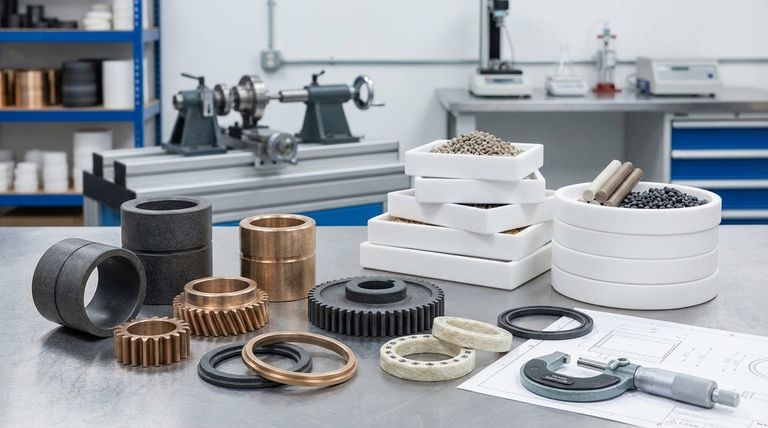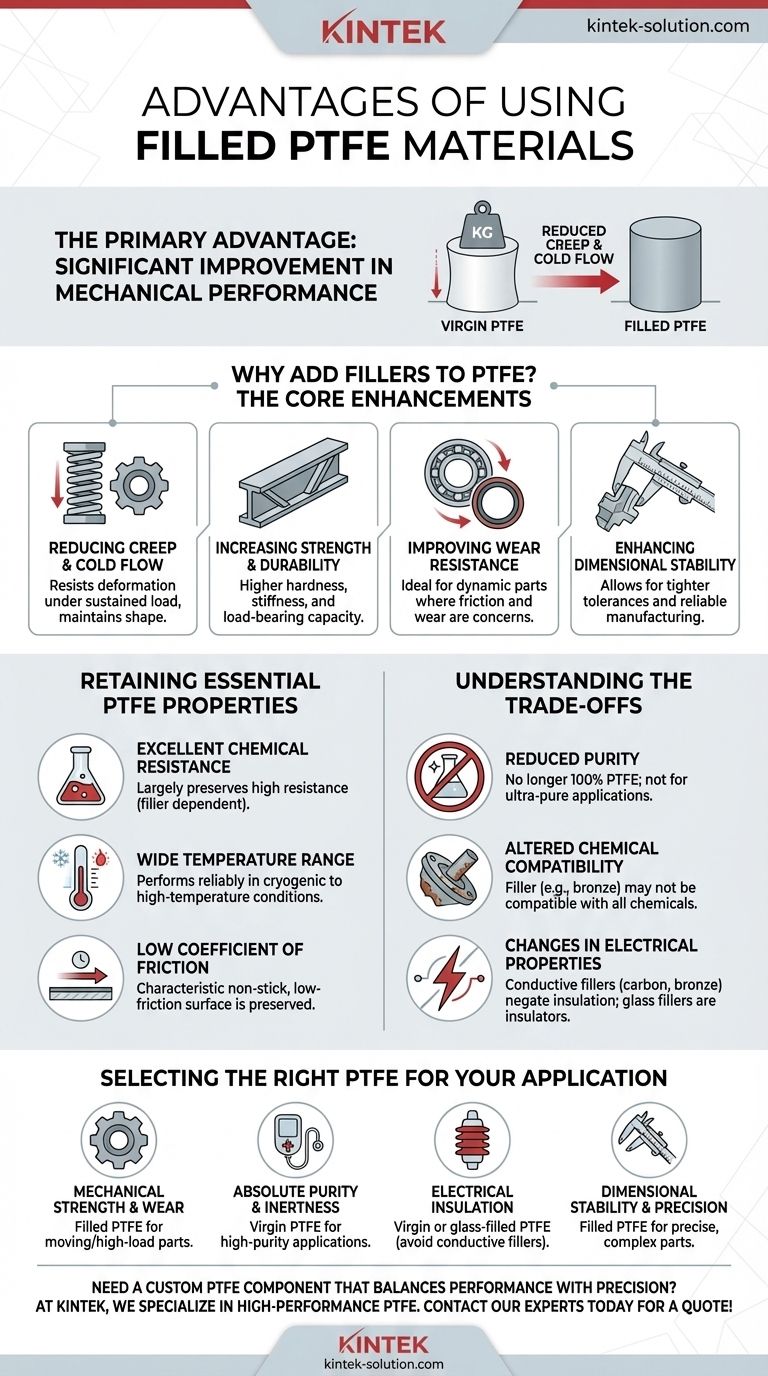The primary advantage of using filled PTFE materials is the significant improvement in mechanical performance over virgin (unfilled) PTFE. By adding fillers like glass, carbon, or bronze, you can drastically reduce unwanted deformation under load (a phenomenon known as creep and cold flow), while increasing the material's overall strength, stiffness, and wear resistance for demanding applications.
Choosing a filled PTFE is a strategic decision to enhance specific mechanical properties like wear resistance and strength. The fundamental trade-off is a reduction in the chemical purity and, depending on the filler, the electrical or chemical inertness of the base PTFE material.

Why Add Fillers to PTFE? The Core Enhancements
While virgin PTFE is known for its exceptional chemical resistance and low friction, its mechanical softness limits its use in structural or high-load applications. Fillers act as a reinforcing agent to overcome these limitations.
Reducing Creep and Cold Flow
Virgin PTFE has a tendency to slowly deform or "flow" when subjected to a sustained compressive load, even at room temperature. Fillers add a rigid internal structure to the material, drastically improving its ability to resist this deformation and maintain its shape under pressure.
Increasing Strength and Durability
The addition of fillers increases the material's hardness, stiffness (compressive strength), and overall durability. This allows filled PTFE components to withstand higher mechanical stress and last longer in abrasive or demanding environments.
Improving Wear Resistance
Fillers like carbon, graphite, and bronze significantly enhance the wear properties of PTFE. This makes the material ideal for dynamic components like bearings, bushings, and seal rings where friction and wear are primary concerns.
Enhancing Dimensional Stability
Because filled PTFE resists creep and thermal expansion better than its virgin counterpart, it is more dimensionally stable. This stability allows for the manufacturing of more complex parts with tighter tolerances that will hold their shape reliably during service.
Retaining the Essential PTFE Properties
Critically, adding fillers enhances mechanical properties while largely preserving the most valuable characteristics of the base PTFE material.
Excellent Chemical Resistance
Filled PTFE generally retains its high resistance to a wide range of chemicals. However, the compatibility of the filler itself must be considered, as materials like bronze may not be suitable for highly corrosive environments.
Wide Temperature Range
The exceptional ability of PTFE to perform across a broad spectrum of temperatures remains. Filled grades can operate reliably in both cryogenic and high-temperature conditions.
Low Coefficient of Friction
The characteristic non-stick, low-friction surface of PTFE is preserved. Certain fillers, such as graphite and Molybdenum Disulfide (MoS2), are lubricants themselves and can further reduce the coefficient of friction.
Understanding the Trade-offs
Selecting a filled material is an engineering decision that requires acknowledging its limitations. The enhancements in one area often come at a cost in another.
Reduced Purity
The most obvious trade-off is purity. The introduction of any filler means the material is no longer 100% PTFE, making it unsuitable for applications with stringent purity requirements, such as in the food, medical, or semiconductor industries.
Altered Chemical Compatibility
The filler material may not share the near-universal chemical inertness of PTFE. For example, a bronze-filled component would be a poor choice for acidic or saltwater applications where virgin PTFE would excel.
Changes in Electrical Properties
Virgin PTFE is one of the best electrical insulators available. Adding a conductive filler like carbon or bronze will completely negate this property, turning the material into a static-dissipative or conductive composite. Glass fillers, being insulators, have a much smaller impact on electrical properties.
Selecting the Right PTFE for Your Application
Your final choice must be guided by the most critical requirement of your specific application.
- If your primary focus is mechanical strength and wear resistance: A filled PTFE is the superior choice for moving or high-load parts like bearings, seals, or structural components.
- If your primary focus is absolute chemical purity and inertness: Virgin PTFE is the only suitable option for applications in medical, food processing, or high-purity electronics.
- If your primary focus is electrical insulation: Virgin or glass-filled PTFE is ideal, but you must avoid conductive fillers like carbon or bronze.
- If your primary focus is dimensional stability for precise parts: Filled PTFE offers superior resistance to deformation, allowing for tighter and more reliable manufacturing tolerances.
By understanding that fillers trade purity for performance, you can confidently select the precise PTFE formulation that meets the demands of your project.
Summary Table:
| Advantage | Key Benefit |
|---|---|
| Reduced Creep & Cold Flow | Drastically resists deformation under sustained load. |
| Increased Strength & Durability | Higher hardness, stiffness, and load-bearing capacity. |
| Improved Wear Resistance | Ideal for dynamic parts like bearings and seals. |
| Enhanced Dimensional Stability | Maintains shape and tolerances for complex parts. |
| Retained Chemical Resistance | Largely preserves PTFE's inertness (filler dependent). |
| Retained Temperature Range | Performs in cryogenic to high-temperature conditions. |
Need a custom PTFE component that balances performance with precision?
At KINTEK, we specialize in manufacturing high-performance PTFE components, including custom filled formulations for the semiconductor, medical, laboratory, and industrial sectors. Whether you need prototypes or high-volume orders, our expertise ensures your parts meet exact mechanical and dimensional requirements.
Contact our experts today to discuss your project and get a quote!
Visual Guide

Related Products
- Custom PTFE Parts Manufacturer for Teflon Containers and Components
- Custom PTFE Parts Manufacturer for Teflon Parts and PTFE Tweezers
- Custom PTFE Teflon Balls for Advanced Industrial Applications
- Custom PTFE Square Trays for Industrial and Laboratory Use
- Custom PTFE Sealing Tapes for Industrial and High Tech Applications
People Also Ask
- What is the hardness range of PTFE on the Shore D scale? Leveraging Its Softness for Superior Performance
- Why is dimensional stability a concern when machining PTFE? Ensure Accurate, Stable PTFE Components
- How is PTFE used in industrial processes? Maximize Safety and Efficiency
- How does PTFE compare to other low-friction plastics like UHMW-PE and Nylon? A Guide to Material Selection
- When and by whom was PTFE discovered? A Tale of Accidental Innovation



















